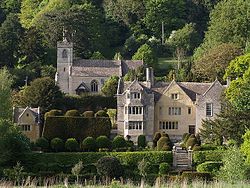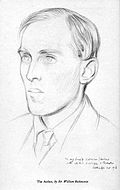Owlpen Manor
| Owlpen Manor | |
| Gloucestershire | |
|---|---|
 Owlpen Manor, with Court House (L) and church | |
| Location | |
| Village: | Owlpen |
| History | |
| By: | Norman Jewson (1926 repairs) |
| Material: | Cotswold stone cruck trusses stone tiled roof |
| Tudor vernacular | |
| Information | |
| Owned by: | Mander family |
Owlpen Manor is a Tudor Grade I listed manor house of the Mander family, in the village of Owlpen in Gloucestershire. There is an associated estate set in a picturesque valley within the Cotswold 'Area of Outstanding Natural Beauty'. The manor house is about one mile east of Uley, and three miles east of Dursley.
Contents
History
Owlpen Manor is widely recognised as one of the most romantic of early manor houses. It has been designated a grade I listed building. The manor house is of mediæval origins, incorporating fabric dated to c. 1200, but was largely built and rebuilt in the Tudor period by the Daunt family, between 1464 and 1616. Since then it has hardly been touched except for small improvements early in the 18th century, when the east wing of the house, together with the gardens, church and Grist Mill, were reordered by Thomas Daunt IV between 1719 and 1726.
Mediæval period
Owlpen (pronounced locally "Ole-pen") derives its name, it is thought, from the name of an Anglo-Saxon thegn, perhaps named Olla, who first set up his pen, or enclosure, by the springs that rise under the foundations of the manor, about the 9th century.
There are records of the de Olepenne family (who must have named themselves after the place) settled at Owlpen by 1174. They were local landowners, benefactors to abbeys and hospitals, and dependants of their feudal overlords, the Berkeleys of Berkeley Castle, whose wills and charters they regularly attest as their attorneys and witnesses. They held Owlpen of the Berkeleys as a sub-manor at half a knight's fee and for a rent of 5s. paid to Wotton manor.
Tudor period
In 1464 the male line failed after twelve generations of Olpennes and the manor and lands passed to the Daunt family on the marriage of Margery de Olepenne to John Daunt of Wotton-under-Edge. The Daunts were clothiers who had been settled in Wotton since the 14th century. They later acquired land in Munster, Ireland, where by 1595 they had their principal estates at Gortigrenane Castle, near Carrigaline, and at Tracton Abbey, near Kinsale, both in County Cork.
There is a tradition that the manor house was visited by Queen Margaret of Anjou before the Battle of Tewkesbury in May 1471, since then her ghost is said to haunt the great chamber where she slept.
The Daunt main line failed on the death of Thomas Daunt VI in 1803.
Nineteenth century
In the nineteenth century, the fortunes of the manor suffered after the Stoughton family, landowners from County Kerry, inherited in 1815. They built a new mansion c. 1848, called Owlpen House, a mile to the east of the original settlement, to the Italianate designs of Samuel Sanders Teulon. It was demolished in 1955-6, though outbuildings including the gas works, lodges and stable block remain.
The Church of the Holy Cross behind the manor house was rebuilt in two phases in 1828 and 1874.
Twentieth century
By the end of the 19th century, the old manor had become celebrated as an icon of the Arts and Crafts movement. It lay in its remote valley as a Sleeping Beauty which had not been inhabited for nearly a hundred years, a picturesque ruin much decayed, overrun with ivy, and dwarfed by enormous yew trees. There was concern for its survival and the Society for the Protection of Ancient Buildings recommended that it should be vested in the National Trust, which however had no funds available for its repair.
Finally, in 1924–25, the Owlpen estate was sold for the first time in nearly a thousand years. The future of the manor house was assured when it was acquired and sensitively repaired by Norman Jewson, a distinguished Cotswold Arts and crafts architect who had worked with Ernest Gimson and the brothers Sidney and Ernest Barnsley (who was his father-in-law) in Sapperton. In 1930, his friend, the artist F L Griggs dedicated his romantic etching of Owlpen Manor to Jewson, who had 'saved this ancient house from ruin'. Jewson has documented his repair work in his classic memoir, By Chance I did Rove (1951, twice reprinted).
Owlpen today
Owlpen Manor is the Gloucestershire home of Sir Nicholas and Lady (Karin) Mander, and their family. Since 1974 they have carefully repaired the manor house and outbuildings, with the cottages and estate, giving them a new and integrated life for the conditions of today. They have re-created the formal Stuart gardens in sympathy with the manor house and added representative family and Cotswold Arts and Crafts collections.
The manor contains a unique series of painted cloth wall-hangings dated about 1700, illustrating the life of Joseph, as well as numerous historic features, including Tudor wall paintings, panelling and plasterwork.
Nicholas Mander's father, the third Mander baronet of The Mount, died in 2006. The Mander family gave Wightwick Manor to the National Trust in 1937.
The manor house and gardens are a popular attraction which has been open to the public since 1966.
Media
In recent years, Owlpen Manor has been used as the location for a number of TV feature films, game shows and documentaries. They include:
- The Fly and the Eagle (a BBC drama about the romance of Bristol poet laureate Robert Southey and Caroline Anne Bowles);
- The Trouble with Home (a documentary about the Manders at Owlpen made for HTV West);
- What the Tudors did for us;
- Countryfile;
- The Other Boleyn Girl (2003 film)
- Watercolour Challenge;
- as well as antiques, cookery, gardening, travel, and art programmes. The holiday cottages and restaurant featured on BBC1’s Holiday programme.
Owlpen Manor appears as Bramscote Court in the BBC's period drama adaptation of Tess of the d'Urbervilles (autumn 2008).
Owlpen Manor has been the inspiration and title of a number of 20th-century poems, including well-known verses by U A Fanthorpe, John Burnside and Reginald Arkell. The house is reputed to have inspired scenes in novels by John Buchan and Wolfgang Hildesheimer.
The Owlpen estate
The Owlpen estate consists of permanent pasture and meadowland fringed by extensive ancient woodland surrounding Owlpen Manor, and traditional farm buildings and cottages.
Nine historic cottages on the estate, including a mill (1728), Court House (1620s), Tithe Barn (c. 1450), and weavers' cottages, are available for holiday accommodation.
There is also an atmospheric restaurant in the mediæval cyder house.
Quotes
- "The loveliest place in England" – Fodor's Britain Guide, 2002
- "The epitome of the English village" – HRH The Prince of Wales, A Vision of Britain, 1989
- "Owlpen in Gloucestershire —ah! What a dream is there!" – Vita Sackville-West
Outside links
References
- Nicholas Mander, Varnished leaves : a biography of the Mander family of Wolverhampton, 1750–1950. Dursley: Owlpen Press. 2004. ISBN 0-9546056-0-8.
- Nicholas Mander, Owlpen Manor, Gloucestershire: a short history and guide to a romantic Tudor manor house in the Cotswolds. (current edition: 2006). OCLC 57576417
- Nicholas Mander, Country Houses of the Cotswolds (Aurum Press, 2008)
- Norman Jewson, By Chance I did Rove (Cirencester, 1951, 1973; Barnsley 1986)
- Hugh E. Pagan, Owlpen Manor (1966, reprinted 1975)
- The Rev. John Daunt, Some Account of the Family of Daunt (Newcastle, 1881; Scarborough, 1899)
